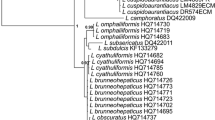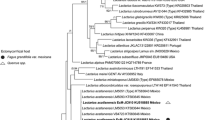Abstract
Ectomycorrhizas (ECM) of Inocybe species (Inocybaceae, Basidiomycota) formed by three host plant species (Populus alba, Salix rosmarinifolia and Pinus nigra) in a semiarid woody steppe of Hungary were studied. To identify the fungal partners, we performed phylogenetic analyses of nucleotide sequences for the internal transcribed spacer region of nuclear DNA (nrDNA ITS) together with sequences gained from public databases. Seven Inocybe ectomycorrhiza morphotypes were morpho-anatomically characterised. Five morphotypes were identified (I. phaeoleuca, I. psammophila, I. semifulva, I. splendens and I. subporospora), whereas two morphotypes represented unidentified Inocybe species. Differences were discernible among the morphotypes, and they showed general anatomical characteristics of Inocybe ECM, such as the slightly organised plectenchymatic mantle (types A, B and E and the gelatinous C). The ECM of I. subporospora and I. phaeoleuca were detected from the introduced Pinus nigra. These two fungi are probably native to the area but capable of forming a novel ectomycorrhizal association with the invasive host.


Similar content being viewed by others
References
Abarenkov K, Tedersoo L, Nilsson RH, Vellak K, Saar I, Veldre V, Parmasto E, Prous M, Aan A, Ots M, Kurina O, Ostonen I, Jõgeva J, Halapuu S, Põldmaa K, Toots M, Truu J, Larsson K-H, Kõljalg U (2010) PlutoF – a web based workbench for ecological and taxonomic research, with an online implementation for fungal ITS sequences. Evol Bioinform 6:189–196. doi:10.4137/EBO.S6271
Agerer R (1987–2008) Colour Atlas of Ectomycorrhizae. Einhorn–Verlag, Schwäbisch Gmünd, München
Agerer R (1991) Characterization of ectomycorrhiza. In: Norris JR, Read DJ, Varma AK (eds) Techniques for the study of mycorrhiza. Methods Microbiol 23:25–73
Agerer R (1995) Anatomical characteristics of identified ectomycorrhizas: an attempt towards a natural classification. In: Varma AK, Hock B (eds) Mycorrhiza: structure, function, molecular biology and biotechnology. Springer, Berlin, pp 685–734
Agerer R (2001) Exploration types of ectomycorrhizae. A proposal to classify ectomycorrhizal mycelial systems according to their patterns of differentiation and putative ecological importance. Mycorrhiza 11:107–114. doi:10.1007/s005720100108
Agerer R, Danielson RM, Egli S, Ingleby K, Luoma D, Treu R (1996–2012) Description of Ectomycorrhizae. Einhorn-Verlag, Schwäbisch Gmünd, München
Altschul SF, Gish W, Miller W, Myers EW, Lipman DJ (1990) Basic local alignment search tool. J Mol Biol 215:403–410
Babos M (1999) Higher fungi (Basidiomycotina) of the Kiskunság National Park and its environs. In: Lőkös L, Rajczy M (eds) The flora of the Kiskunság National Park, II. Cryptogams. MTM, Budapest, pp 199–298
Beenken L (1996a) Inocybe appendiculata. In: Agerer R (ed) Colour atlas of ectomycorrhizae. Einhorn–Verlag, Schwäbisch Gmünd, München, table 94
Beenken L (1996b) Inocybe fuscomarginata. In: Agerer R (ed) Colour atlas of ectomycorrhizae. Einhorn–Verlag, Schwäbisch Gmünd, München, table 95
Beenken L (1996c) Inocybe obscurobadia. In: Agerer R (ed) Colour atlas of ectomycorrhizae. Einhorn–Verlag, Schwäbisch Gmünd, München, table 96
Beenken L (1996d) Inocybe terrigena. In: Agerer R (ed) Colour atlas of ectomycorrhizae. Einhorn–Verlag, Schwäbisch Gmünd, München, table 97
Beenken L, Agerer R, Bahnweg G (1996a) Inocybe appendiculata Kühn. + Picea abies (L.) Karst. Descr Ectomyc 1:35–40
Beenken L, Agerer R, Bahnweg G (1996b) Inocybe fuscomarginata Kühn. + Salix spec., Populus nigra L. Descr Ectomyc 1:41–46
Beenken L, Agerer R, Bahnweg G (1996c) Inocybe obscurobadia (J. Favre) Grund & D. E. Stuntz + Picea abies (L.) Karst. Descr Ectomyc 1:47–52
Beenken L, Agerer R, Bahnweg G (1996d) Inocybe terrigena (Fr.) Kuyper + Pinus sylvestris L. Descr Ectomyc 1:53–58
Britzelmayr M (1891) Hymenomyceten aus Südbayern. VII. Teil. R. Friedländer & Sohn, Berlin
Cripps CL (1997) Inocybe lacera (Fr.: Fr.) Kumm. + Populus tremuloides Michx. Descr Ectomyc 2:19–23
Cripps CL, Miller OK Jr (1995) Ectomycorrhizae formed in vitro by quaking aspen: including Inocybe lacera and Amanita pantherina. Mycorrhiza 5:357–370
Gardes M, Bruns TD (1993) ITS primers with enhanced specificity for basidiomycetes application to the identification of mycorrhizae and rusts. Mol Ecol 2:113–118. doi:10.1111/j.1365-294X.1993.tb00005.x
Glen M, Tommerup IC, Bougher NL, O’Brien PA (2001) Interspecific and intraspecific variation of ectomycorrhizal fungi associated with Eucalyptus ecosystems as revealed by ribosomal DNA PCR–RFLP. Mycol Res 105:843–858. doi:10.1017/S095375620100418X
Gouy M, Guindon S, Gascuel O (2010) SeaView version 4: a multiplatform graphical user interface for sequence alignment and phylogenetic tree building. Mol Biol Evol 27:221–224. doi:10.1093/molbev/msp259
Hall TA (1999) BioEdit: a user-friendly biological sequence alignment editor and analysis program for windows 95/98/NT. Nucleic Acids Symp Ser 41:95–98
Horak E (1977) Fungi agaricini novaezelandiae VI. Inocybe (Fr.) Fr. and Astrosporina schroeter. N Z J Bot 15:713–747
Huelsenbeck JP, Ronquist F (2001) MRBAYES: Bayesian inference of phylogenetic trees. Bioinformatics 17:754–755. doi:10.1093/Bioinformatics/17.8.754
Ilyas S, Razaq A, Khalid AN (2013) Inocybe nitidiuscula and its ectomycorrhizae associated with Alnus nitida from Galyat, Pakistan. Mycotaxon 124:247–254
Ingleby K (1999) Inocybe avellana Horak + Shorea leprosula Miq. Descr Ectomyc 4:55–60
Ingleby K, Mason PA, Last FT, Fleming LV (1990) Identification of ectomycorrhizas. ITE research publication no. 5. HMSO, London
Jacobsson S, Larsson E (2012) Inocybe (Fr.) Fr. In: Knudsen H, Vesterholt J (eds) Funga Nordica. Agaricoid, boletoid, clavarioid, cyphelloid and gastroid genera. Nordsvamp, Nordsvamp, Copenhagen, pp 981–1021
Katoh K, Standley DM (2013) MAFFT multiple sequence alignment software version 7: improvements in performance and usability. Mol Biol Evol 30:772–780. doi:10.1093/molbev/mst010
Kirk PM, Cannon PF, Minter DW, Stalpers JA (2008) Dictionary of the fungi, 10th edn. CABI, Wallingford
Knapp DG, Pintye A, Kovács GM (2012) The dark side is not fastidious — dark septate endophytic fungi of native and invasive plants of semiarid sandy areas. PLoS ONE 7:e32570. doi:10.1371/journal.pone.0032570
Kõljalg U, Nilsson RH, Abarenkov K, Tedersoo L, Taylor AFS, Bahram M, Bates ST, Bruns TD, Bengtsson-Palme J, Callaghan TM, Douglas B, Drenkhan T, Eberhardt U, Dueñas M, Grebenc T, Griffith GW, Hartmann M, Kirk PM, Kohout P, Larsson E, Lindahl BD, Lücking R, Martín MP, Matheny PB, Nguyen NH, Niskanen T, Oja J, Peay KG, Peintner U, Peterson M, Põldmaa K, Saag L, Saar I, Schüßler A, Scott JA, Senés C, Smith ME, Suija A, Taylor DL, Telleria MT, Weiß M, Larsson K-H (2013) Towards a unified paradigm for sequence-based identification of fungi. Mol Ecol 22:5271–5277. doi:10.1111/mec.12481
Kovács GM, Szigetvári C (2002) Mycorrhizae and other root-associated fungal structures of the plants of a sandy grassland on the great Hungarian plain. Phyton Ann Rei Bot 42:211–223
Kovács GM, Trappe JM, Alsheikh AM, Bóka K (2008) Imaia, a new truffle genus to accomodate Terfezia gigantea. Mycologia 100:930–939. doi:10.3852/08-023
Larsson E, Ryberg M, Moreau P-A, Delcuse Mathiesen Å, Jacobsson S (2009) Taxonomy and evolutionary relationships within species of section Rimosae (Inocybe) based on ITS, LSU and mtSSU sequence data. Persoonia 23:86–98. doi:10.3767/003158509X475913
Magyar L, Beenken L, Jakucs E (1999) Inocybe heimii Bon + Fumana procumbens (Dun.) Gr. Godr. Descr Ectomyc 4:61–65
Matheny PB, Ammirati JF (2003) Inocybe angustispora, I. taedophila, and Cortinarius aureifolius: an unusual inocyboid Cortinarius. Mycotaxon 88:401–407
Matheny PB, Watling R (2004) A new and unusual species of Inocybe (Inosperma clade) from tropical Africa. Mycotaxon 89:497–503
Matheny PB, Aime MC, Bougher NL, Buyck B, Desjardin DE, Horak E, Kropp BR, Lodge DJ, Soytong K, Trappe JM, Hibbett DS (2009) Out of the palaeotropics? Historical biogeography and diversification of the cosmopolitan ectomycorrhizal mushroom family Inocybaceae. J Biogeogr 36:577–592. doi:10.1111/j.1365-2699.2008.02055.x
Nagy L (2004) Fungisztikai vizsgálatok az Alföldön 1997 és 2003 között. [Fungistical investigations on the Great Hungarian Plain from 1997 to 2003]. Mikol Közlem, Clusiana 43:15–46
Nagy L, Gorliczai Z (2007) Újabb adatok az Alföld gombavilágához. [Further data to the knowledge of the fungi of the Great Hungarian Plain]. Mikol Közlem, Clusiana 46:211–256
Nagy LG, Kocsubé S, Csanádi Z, Kovács GM, Petkovits T, Vágvölgyi C, Papp T (2012) Re-mind the gap! insertion – deletion data reveal neglected phylogenetic potential of the nuclear ribosomal internal transcribed spacer (ITS) of fungi. PLoS ONE 7:e49794. doi:10.1371/journal.pone.0049794
Nuñez MA, Dickie IA (2014) Invasive belowground mutualists of woody plants. Biol Invasions 16:645–661. doi:10.1007/s10530-013-0612-y
Nylander JAA, Wilgenbusch JC, Warren DL, Swofford DL (2007) AWTY (Are we there yet?): a system for graphical exploration of MCMC convergence in Bayesian phylogenetics. Bioinformatics 24:581–583. doi:10.1093/bioinformatics/btm388
Ronquist F, Huelsenbeck JP (2003) MrBayes 3: Bayesian phylogenetic inference under mixed models. Bioinformatics 19:1572–1574. doi:10.1093/bioinformatics/btg 180
Ryberg M, Matheny PB (2012) Asynchronous origins of ectomycorrhizal clades of Agaricales. Proc R Soc B 279:2003–2011. doi:10.1098/rspb.2011.2428
Ryberg M, Nilsson RH, Kristiansson E, Töpel M, Jacobsson S, Larsson E (2008) Mining metadata from unidentified ITS sequences in GenBank: a case study in Inocybe (Basidiomycota). BMC Evol Biol 8:50. doi:10.1186/1471-2148-8-50
Silvestro D, Michalak I (2012) RaxmlGUI: a graphical front-end for RAxML. Org Divers Evol 12:335–337. doi:10.1007/s13127-011-0056-0
Simmons MP, Ochoterena H, Carr TG (2001) Incorporation, relative homoplasy, and effect of gap characters in sequence-based phylogenetic analysis. Syst Biol 50:454–462. doi:10.1080/106351501300318049
Staden R, Beal KF, Bonfield JK (2000) The staden package, 1998. Methods Mol Biol 132:115–130
Stamatakis A (2014) RAxML version 8: a tool phylogenetic analysis and post-analysis of large phylogenies. Bioinformatics 30:1312–1313. doi:10.1093/bioinformatics/btu033
Tamás J (2003) The history of Austrian pine plantations in Hungary. Acta Bot Croat 62:147–158
Tamura K, Peterson D, Peterson N, Stecher G, Nei M, Kumar S (2011) MEGA5: molecular evolutionary genetics analysis using maximum likelihood, evolutionary distance, and maximum parsimony methods. Mol Biol Evol 28:2731–2739. doi:10.1093/molbev/msr121
Wang B, Qiu YL (2006) Phylogenetic distribution and evolution of mycorrhizas in land plants. Mycorrhiza 16:299–363. doi:10.1007/s00572-005-0033-6
White TJ, Bruns TD, Lee S, Taylor JW (1990) Amplification and direct sequencing of fungal ribosomal RNA genes for phylogenetics. In: Innis MA, Gelfand DH, Sninsky JJ, White TJ (eds) PCR protocols: a guide to methods and applications. Academic, San Diego, pp 315–322
Young ND, Healy J (2003) GapCoder automates the use of indel characters in phylogenetic analysis. BMC Bioinforma 4:6. doi:10.1186/1471-2105-4-6
Acknowledgments
We thank Csilla Jónás for preparing slides for microscopy and Márk Z. Németh for assistance with image processing. Gábor M. Kovács is supported by a Bolyai János Research Fellowship (Hungarian Academy of Sciences).
Author information
Authors and Affiliations
Corresponding author
Rights and permissions
About this article
Cite this article
Seress, D., Dima, B. & Kovács, G.M. Characterisation of seven Inocybe ectomycorrhizal morphotypes from a semiarid woody steppe. Mycorrhiza 26, 215–225 (2016). https://doi.org/10.1007/s00572-015-0662-3
Received:
Accepted:
Published:
Issue Date:
DOI: https://doi.org/10.1007/s00572-015-0662-3




